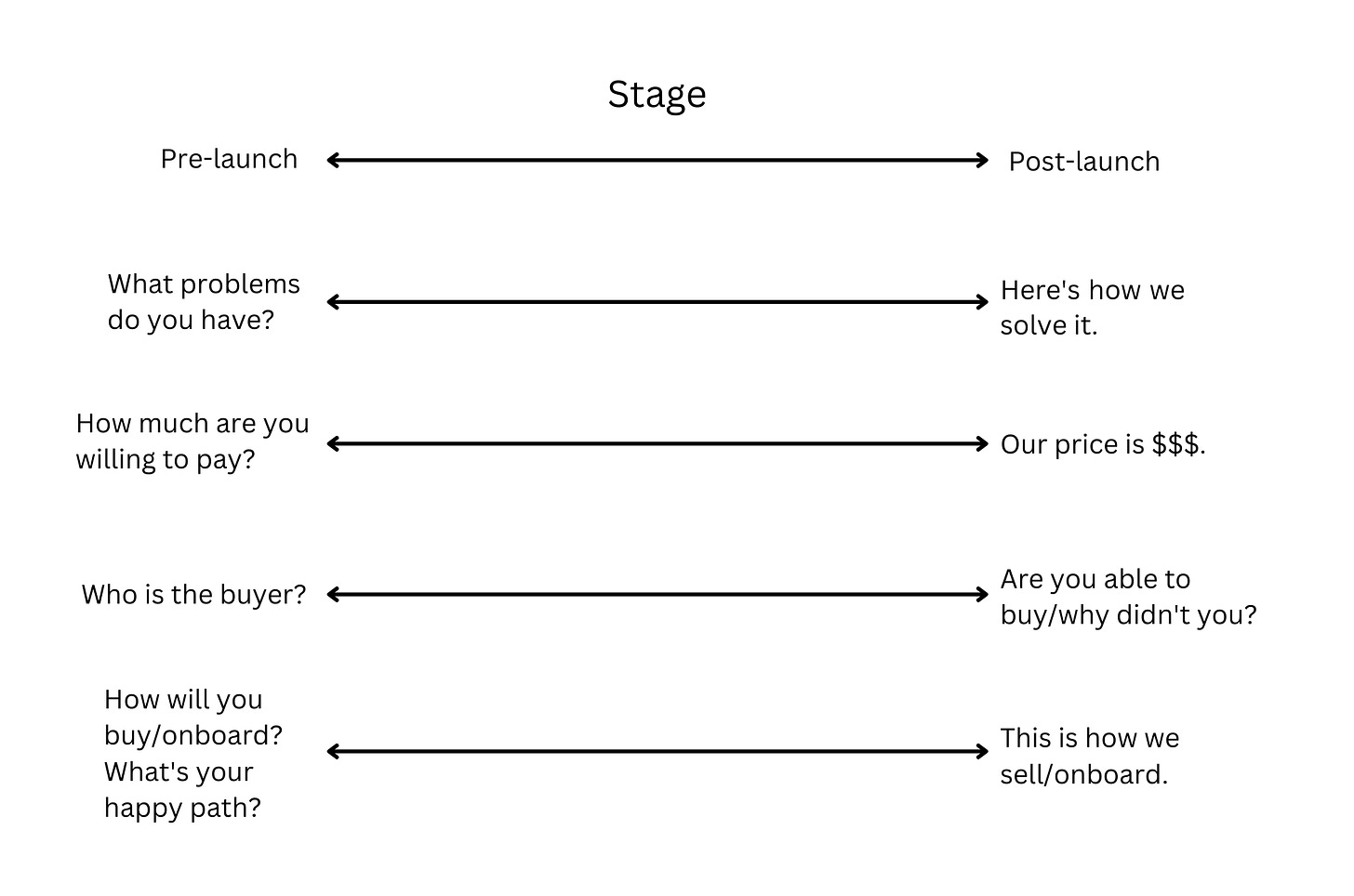How to Have Effective Sales Conversations After You Launch
As discussed in the prior post, you should spend 70-80% of your time on sales and marketing post-product launch. This means that you will spend significantly less time on customer discovery. For many founders, this requires a mental shift – you’re used to conducting conversations with one goal, discovery, and now you need to tailor your conversations around a new goal, selling. Let’s explore how to navigate that shift.
First, ensure you’re clearly distinguishing between discovery/validation and selling. They bleed into each other but are distinct, with different goals. You must be clear about your goals for each interaction and adjust accordingly. The goal of validation conversations is to understand the problem faced by the buyer and what solution to build, how to build it, and how to price it effectively. Post-launch, your goal is to raise awareness about your solution, determine if the person you’re speaking to is a buyer, and get them to pay you for it.
Sales and marketing motions can inform your product roadmap, but discovering new features is not the goal. Don’t fall into the trap of always building features to handle prospective buyers' objections. If they tell you they won’t buy until you have a specific feature, put them in the potential future customer bucket. Don’t let building new features be a blocker to selling. One exception is if, without your prompting, you get continuous feedback from potential customers saying they can’t buy because of the same missing feature. If you can’t make a single sale because of a missing feature, then it may be time to consider adding it asap. Note that this is after a reasonable amount of sales and marketing interactions. Don’t stop selling to go build a new feature after 2 or 3 conversations.
Your primary product discovery post-launch should be done with paying customers. These are the people whose opinion matters most to you now that you’ve launched a validated product. Place more emphasis on their feedback. If possible, it’s great to automate feedback collection from existing customers. Given the need to optimize your time for sales conversations, you’ll need to introduce efficiency into the product feedback loop. Several tools for capturing customer feedback include Uservoice, Pendo, Hotjar, and simple tools like Typeform. Then dig deeper and be strategic about your 1:1 customer feedback conversations.
The Conversation Spectrum
To help you execute effectively as both a builder and a seller, I want you to think you are having your conversations on a continuum, with one end being pre-launch discovery and one end being post-launch sales. Placing yourself in the appropriate place on the spectrum will help you frame your conversations effectively, whether it’s product discovery or sales. Find your place on the spectrum, and adjust your strategy:
Keep this framework in mind as you progress through discovery and product launch.
Find Your Confidence
Selling is “risky.” It’s where you’ll face rejection. Customer discovery is more comfortable; hence founders use product discovery as a crutch, making them feel productive, and the sting of a “no” doesn’t hurt so bad. But after you’ve validated and built your idea, your job is to get out there, acquire customers, and grow.
Many founders are not confident selling because they aren’t confident in what they’re selling. You have to believe in your product to succeed. You built this solution to solve a problem. Now go out there and solve the problem. It’s normal to be uncomfortable with sales, but it’s only by doing sales and marketing that you’ll get comfortable selling and better at marketing. Learning, the volume of work and frequency of practice are among the most important things in sales and marketing. You’re a pianist and won’t become world-class without putting in hours and hours of practice. Of course, you have to know how to play the piano, but the time spent actually playing is what will make you great. Sales work in the same way. Resources and learning are helpful, but at the end of the day, only getting out there and doing sales will teach you what works and what doesn’t so you can keep improving. Learn, then do. Over and over.
Do you have testimonials? Do you have recordings of customer validation conversations where someone was excited about your product? These are great ways to remind you you’re solving a problem for real people. Remember, you’re on a journey.
Find what works for you and clarify your goals with every conversation.
Let me know what you thought of this newsletter here, on Twitter, or on Instagram.



Many founders are not confident selling because they aren’t confident in what they’re selling. You have to believe in your product to succeed. This surprised me. I would expect a founder to be emotionally attached and over confident of their product -- " I think this is great so you should too"